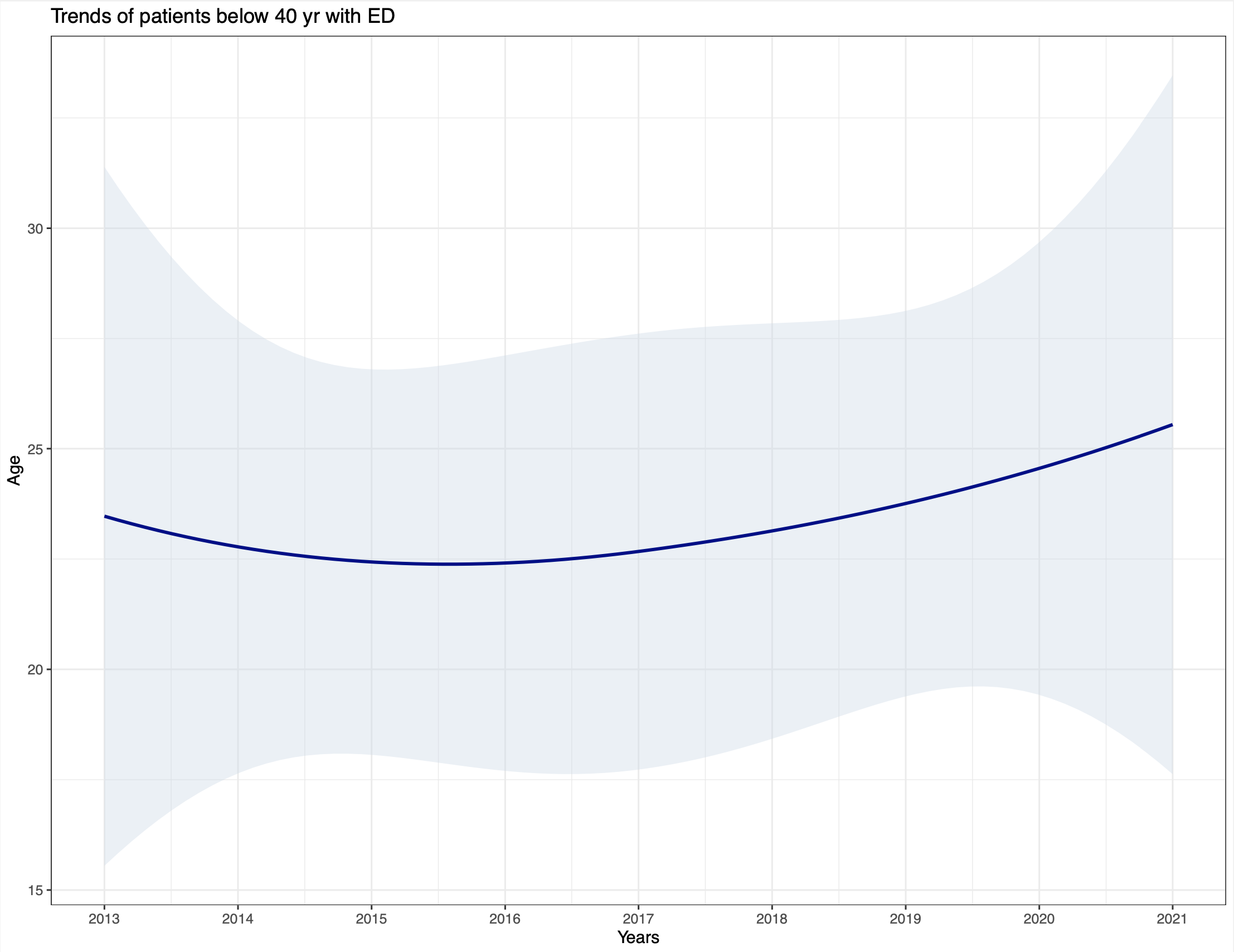Back
Poster, Podium & Video Sessions
Moderated Poster
MP21: Sexual Function/Dysfunction: Evaluation I
MP21-12: Still one out of five men presenting for erectile dysfunction are young than 40 years of age: findings of a real-life cross-sectional study over last decade
Saturday, May 14, 2022
7:00 AM – 8:15 AM
Location: Room 222
Edoardo Pozzi*, Milan, Italy, Paolo Capogrosso, Varese, Italy, Giuseppe Fallara, Luca Boeri, Christian Corsini, Daniele Cignoli, Massimiliano Raffo, Luigi Candela, Nicolò Schifano, Alessia d'Arma, Rayan Matloob, Milan, Italy, Federico Dehò, Varese, Italy, Vincenzo Mirone, Naples, Italy, Francesco Montorsi, Andrea Salonia, Milan, Italy
- EP
Poster Presenter(s)
Introduction: Erectile dysfunction (ED) has been demonstrated to be reasonably prevalent among young men (=40 yr). We aimed to i) assess changes in patterns of reported ED in men = 40 yr, and ii) compare the sociodemographic and clinical characteristics of ED men = 40 yr vs. > 40 yr of age over a 8-yr period at a single academic centre.
Methods: Data of 1179 patients seeking first medical help for ED and assessed by a single Sexual Medicine expert between 2013 and 2021 were analysed. All patients completed the IIEF at baseline. Descriptive statistics tested the sociodemographic and clinical characteristics of ED men = 40 yr vs. > 40 yr of age. Within the two groups, multivariable linear regression models tested the association between advancing age and IIEF scores. Local polynomial regression models were applied to explore and graphically display = 40 yr patients’ likelihood to report ED over the analysed time frame and to display changes of the IIEF-EF scores over increasing age between the two groups.
Results: Overall, median (IQR) age was 52 (41-62) yr. Median (IQR) IIEF-EF was 18 (15-22) at baseline. Of all, 268 (22.7%) were = 40 yr whereas 911 (77.3%) were > 40 yr at baseline. Rates of severe ED according to IIEF-EF did not differ between men = 40 yr and >40yr (60 (22.4%) vs. 155 (17%)). No significant differences were found for the IIEF domains (-IS, -OS, -SD) but IIEF-OF domains, which scored higher in younger men (9 () vs. 8 (), p=0.002). At baseline, younger patients reported less comorbidities, less active smoking, lower BMI, higher total testosterone (tT) levels than older patients (all p<0.005). At linear regression models, within the = 40 yr group, increasing age was not associated with changes across all IIEF domains. In contrast, in men > 40 yr, increasing age was linearly correlated with decreasing IIE-EF (all p<0.001), after adjusting for tT, BMI, CCI, smoking and arterial hypertension. Figure 1 graphically displays a stable 8-yr temporal trend of = 40 yr ED patients
Conclusions: One out of five men seeking first medical help for ED at a single academic centre were younger than 40 yr. This trend has remained stable over the last 8-years. Increasing age among younger patients is not associated with worse erectile function as oppositely occurs among patients > 40 yr.
Source of Funding: N/A

Methods: Data of 1179 patients seeking first medical help for ED and assessed by a single Sexual Medicine expert between 2013 and 2021 were analysed. All patients completed the IIEF at baseline. Descriptive statistics tested the sociodemographic and clinical characteristics of ED men = 40 yr vs. > 40 yr of age. Within the two groups, multivariable linear regression models tested the association between advancing age and IIEF scores. Local polynomial regression models were applied to explore and graphically display = 40 yr patients’ likelihood to report ED over the analysed time frame and to display changes of the IIEF-EF scores over increasing age between the two groups.
Results: Overall, median (IQR) age was 52 (41-62) yr. Median (IQR) IIEF-EF was 18 (15-22) at baseline. Of all, 268 (22.7%) were = 40 yr whereas 911 (77.3%) were > 40 yr at baseline. Rates of severe ED according to IIEF-EF did not differ between men = 40 yr and >40yr (60 (22.4%) vs. 155 (17%)). No significant differences were found for the IIEF domains (-IS, -OS, -SD) but IIEF-OF domains, which scored higher in younger men (9 () vs. 8 (), p=0.002). At baseline, younger patients reported less comorbidities, less active smoking, lower BMI, higher total testosterone (tT) levels than older patients (all p<0.005). At linear regression models, within the = 40 yr group, increasing age was not associated with changes across all IIEF domains. In contrast, in men > 40 yr, increasing age was linearly correlated with decreasing IIE-EF (all p<0.001), after adjusting for tT, BMI, CCI, smoking and arterial hypertension. Figure 1 graphically displays a stable 8-yr temporal trend of = 40 yr ED patients
Conclusions: One out of five men seeking first medical help for ED at a single academic centre were younger than 40 yr. This trend has remained stable over the last 8-years. Increasing age among younger patients is not associated with worse erectile function as oppositely occurs among patients > 40 yr.
Source of Funding: N/A


.jpg)
.jpg)